Tennessee is really a fascinating place, particularly for history buffs. There are sites exemplifying pioneer history, the founding of the United States, the Civil War, the Great Depression, WWII, and the Civil Rights Movement – all easily accessible from Knoxville (itself named after Henry Knox, Revolutionary War hero and Secretary of War under President Washington). Most interesting to me is that America as the grand experiment – a country founded on an idea, not on an ethnicity – is really put to the test in Tennessee, on more than one occasion. Tennessee’s history records a few challenges to the U.S. Constitution which demonstrate the balancing act between the rugged individualism Americans pride themselves on and rule of law for the greater good of the country. E Pluribus Unum: Out of Many, One.
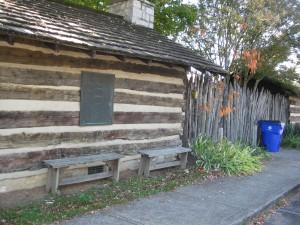
James White’s Fort – first settlement in Knoxville. He arrived 1783.
The ruggedness of early American settlers is on full display at James White’s Fort, where entertaining guides, Director Sam Maynard and Curator Robert McGinnis, narrate the history of the fort and of Knoxville’s founding family. In 1770, when James White and Mary Larson married, he was in his twenties and she was 11 or 12. While that might seem wrong to our modern sensibilities, Robert McGinnis is glad the union took place – he’s an eighth generation great-grandson, descended from their daughter Margaret! In later years (probably during the Victorian era), someone changed the age on Mary’s tombstone to make her older than James at the time of their marriage.
With knowledge and humor, the guides expound on the harsh realities of life for our country’s pioneers.
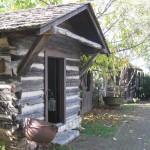
I’m always most interested in what the experience was like for the people living then. The bedroom on the second floor of the fort’s main house could accommodate 20-25 people in beds and probably regularly slept 10-12, adults and children. With so many people sleeping in one room, I wonder what it was like to use the chamber pot at night. Forget about privacy. How could the others sleep with the smell? Even more perplexing – how did the families get big enough to have 12 people sleeping in a room when 12 people were sleeping in the room? Robert said he’d been curious about the same things when he was interviewing some elderly residents. After she warmed up to him, one woman told him that you just went to sleep! Life was physically demanding and sleep was in short supply. The kids knew about the birds and the bees from being around livestock; it was an accepted part of life. It seems there was much less embarrassment about bodily functions back then. While I think being in actual physical proximity with life in all of its glory and grossness is probably healthier, I am grateful for the cleanliness, convenience, and privacy of life today.
The founding of the country and a Constitutional challenge are represented by another historic Knoxville residence, the Blount Mansion. William Blount served in the North Carolina forces during the Revolutionary War, represented North Carolina at the Continental Congress, signed the Constitution for North Carolina, and appointed by President Washington as Governor for the Territory South of the River Ohio, he played an integral part in the Constitutional Convention that converted part of that land into Tennessee. He served as one of Tennessee’s first senators – until he was almost impeached! Settlers in the frontier regions were very unhappy with Spain’s control of the Mississippi River which was negatively impacting their trade. Dissatisfied with the federal government’s lack of action, William Blount allegedly decided to take matters into his own hands by contacting British agents to ask for help in taking over Florida and Louisiana. (As the narrator of the not-to-be-missed tongue-in-cheek information film at the mansion’s visitor center deadpans, “That’s called treason.”)
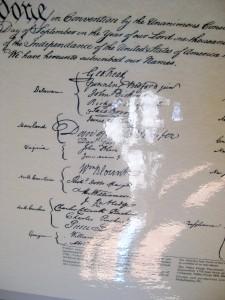
Blount signed Constitution for NC (top name 4th state down)
It amazes me that a signer of the Constitution would have orchestrated a conspiracy against the very document he helped to create. Blount wholeheartedly supported the westward expansion of the new nation and firmly believed that only a strong central government could sustain it. Yet he wasn’t willing to abide by the decisions of the federal government when they opposed his own beliefs about what should be done. A letter he wrote mentioning the plan was intercepted, and Blount was kicked out of the Senate. The House impeached him but the Senate decided that dismissal was enough. The people of Tennessee, however, still loved him! He was elected to the State Senate and served as speaker until he died a few years later.
How many Hollywood films feature the hero who goes rogue against the establishment? It’s part of being American – balancing this independent spirit with rule of law along a tightrope of absolute integrity. It’s the depressing dramas or film noirs that focus on the everyman character making the less courageous choice to give up on ideals and give in to an established system. (I am reminded of a Chinese tourist who attended one of my tours in Philadelphia. When he heard about the excitement over a proposed visit by the Dalai Lama, he said to me, confused, “But don’t you know he’s a criminal?”) It’s America’s paradox – the strong independent thinkers required for democracy’s implementation are also its greatest challenge.
In addition to a history of events fascinating to ponder, the mansion also offers an insightful look at life at the end of the 18th and into the 19th centuries. Funnily enough, the only original piece in the house is the ‘potty chair.’ We also saw a creepy, partially burnt (or maybe just dirty) doll that was found in the rafters
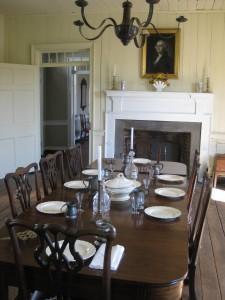
The house transitions easily into the 19th century; Civil war buffs will appreciate that Belle Boyd, notorious Confederate female spy, was entertained in the mansion when it belonged to the family of Judge Samuel Boyd. The teenage spy became something of a celebrity – thus hindering her success at future spying!
Knoxville remains historically relevant in the 20th century as well. One might think that a
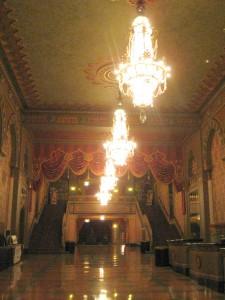
Tennessee Theater – 1928 movie palace
place associated with the history of the Great Depression would be, well, depressing, but actually the Tennessee Theater is anything but. It was built in 1928 as an opulent movie palace for Paramount and was restored to its original grandeur with additional capacities to equip it as a major performing arts venue. Movie palaces constructed during the Depression were particularly elaborate and glamorous to help ordinary people escape from the tough reality that surrounded them. I could vividly imagine the dramatic light plays from exotic lamps, intricate plush carpets, and ornate painted seats with velvet cushions providing perfect accents to a flapper with an elegant cigarette holder and strands of long pearls. The organ is original to the theater, and the spectacular chandeliers, worth one quarter of a million dollars each, were reportedly named after the stagehands’ girlfriends.
As the Great Depression gives way to WWII, Tennessee is in the spotlight again. Just 30-40 minutes away from Knoxville is Oak Ridge, the secret city created as a site of the ‘Manhattan Project.’ A visit to the American Museum of Science and Energy (AMSE) really makes this incredible wartime project – to produce an atomic bomb before the Germans did – come alive. In 1942 when the city was created on a 59,000-acre tract of land, there were about 3,000 residents already there. In just 1 ½ years, the population high reached 75,000. At the height of construction, a house reportedly went up every half hour. I was able to walk through one of the single-story prefab homes called cemestos and imagine what it was like to live and work in this community. Better than any sci-fi movie – and it was real!
In today’s world of all-pervasive social media and Internet tracking, it is hard to conceptualize a place – in our nation’s not-so-distant history – with so much secrecy. With steadfast dedication to the cause, Oak Ridge residents trusted the government’s dictums limiting their freedoms, put their heads down and continued working even as their own human dramas unfolded. Scientists and others invited to work there had two weeks to move and be at work. Each group and department was isolated from what any other
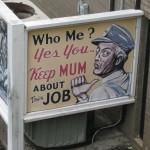
One of the most memorable places I visited near Knoxville was the Green McAdoo Cultural Center and
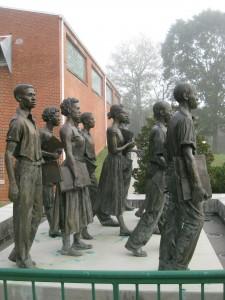
What amazed me most of all about the events surrounding the desegregation was the absence of idealistic or heroic rhetoric; both black and white citizens and the students themselves saw themselves as simply upholding the law. They were doing their duty to obey the Constitution, that living, breathing, ever-evolving piece of parchment completely imbued with the power we give it. Our power as we voice our opinions and elect our leaders who put the words there. Our power as we implement what the words command. The power of words that expands beyond the document itself to move the forces of history.
The initial integration of Clinton High School went smoothly enough until some troublemakers from out of state decided that if desegregation could be stopped at the first public high school to try it, it could be stopped at all of them. A subsection of the town banded together during the KKK-executed turmoil, until the National Guard came in. Those 12 students were brave – high school is hard enough without having physical danger on the way in. What a challenge for the school administration, and the parents. Things eventually settled down, but I imagine it was pretty lonely for those kids. They persevered, one foot in front of the other each day, moving forward to make it easier for future generations. As the docent, a lifelong resident of Clinton, said, “It was chaotic, but we overcame.”
Throughout our nation’s history, the question of what it means to be an American has reverberated through the mountains and across the river valleys of Tennessee. It’s not possible to visit the Knoxville area and not hear it. I’m always striving to get in the shoes of those who have come before me, to contemplate what I might have done and how I might have felt. It helps me understand better my place in the world today. The Knoxville area sites and the events that took place at them do not illustrate a history that is dead and gone but one that is still very much alive and growing. I’m excited to see what’s next!
Disclosure: My trip Knoxville, TN, was made possible by the Tennessee Department of Tourist Development. My opinions and perspectives are totally my own — as always

